Human Resource Management Strategic Plan for National Australia Bank
VerifiedAdded on 2023/06/15
|12
|2002
|74
Report
AI Summary
This report provides a comprehensive analysis of Human Resource Management (HRM) strategic planning for the National Australia Bank, addressing the organization's strategic failures and the need for improved employee retention. It prioritizes three key programs: recruitment, career development, and employee relations. The recruitment process focuses on attracting skilled employees for marketing and development positions to boost growth in the Australian market. The career development plan aims to provide opportunities for promotion and skill enhancement, fostering employee retention and identifying talent for organizational development. The employee relations program emphasizes building mutual trust, improving workplace environment, and enhancing communication to increase productivity and combat adverse situations. The report concludes with recommendations for each program, including phased recruitment, career development counseling, and communication development initiatives, to ensure the successful implementation of the HRM strategy and address the identified issues within the National Australia Bank. Desklib provides students access to similar solved assignments and past papers for learning.
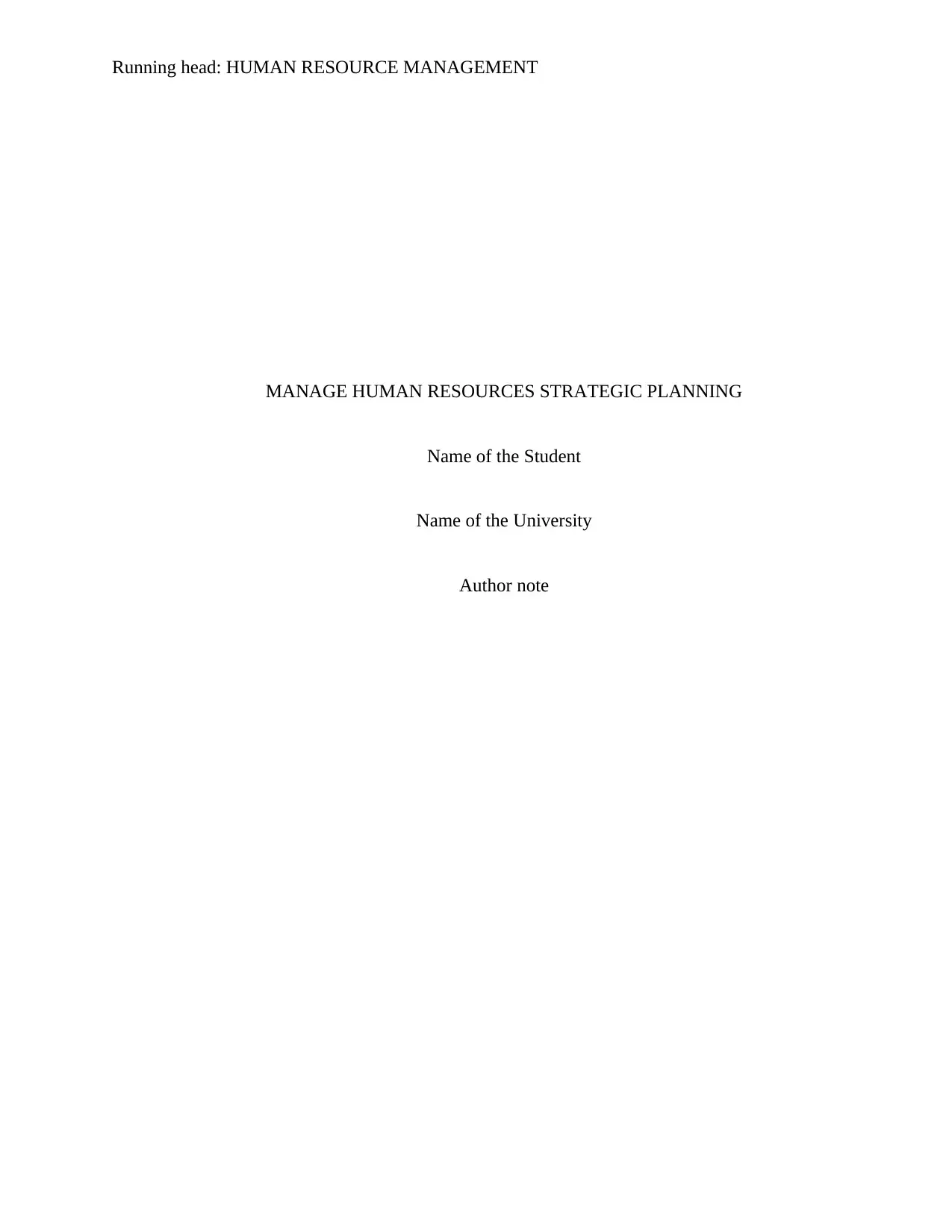
Running head: HUMAN RESOURCE MANAGEMENT
MANAGE HUMAN RESOURCES STRATEGIC PLANNING
Name of the Student
Name of the University
Author note
MANAGE HUMAN RESOURCES STRATEGIC PLANNING
Name of the Student
Name of the University
Author note
Paraphrase This Document
Need a fresh take? Get an instant paraphrase of this document with our AI Paraphraser
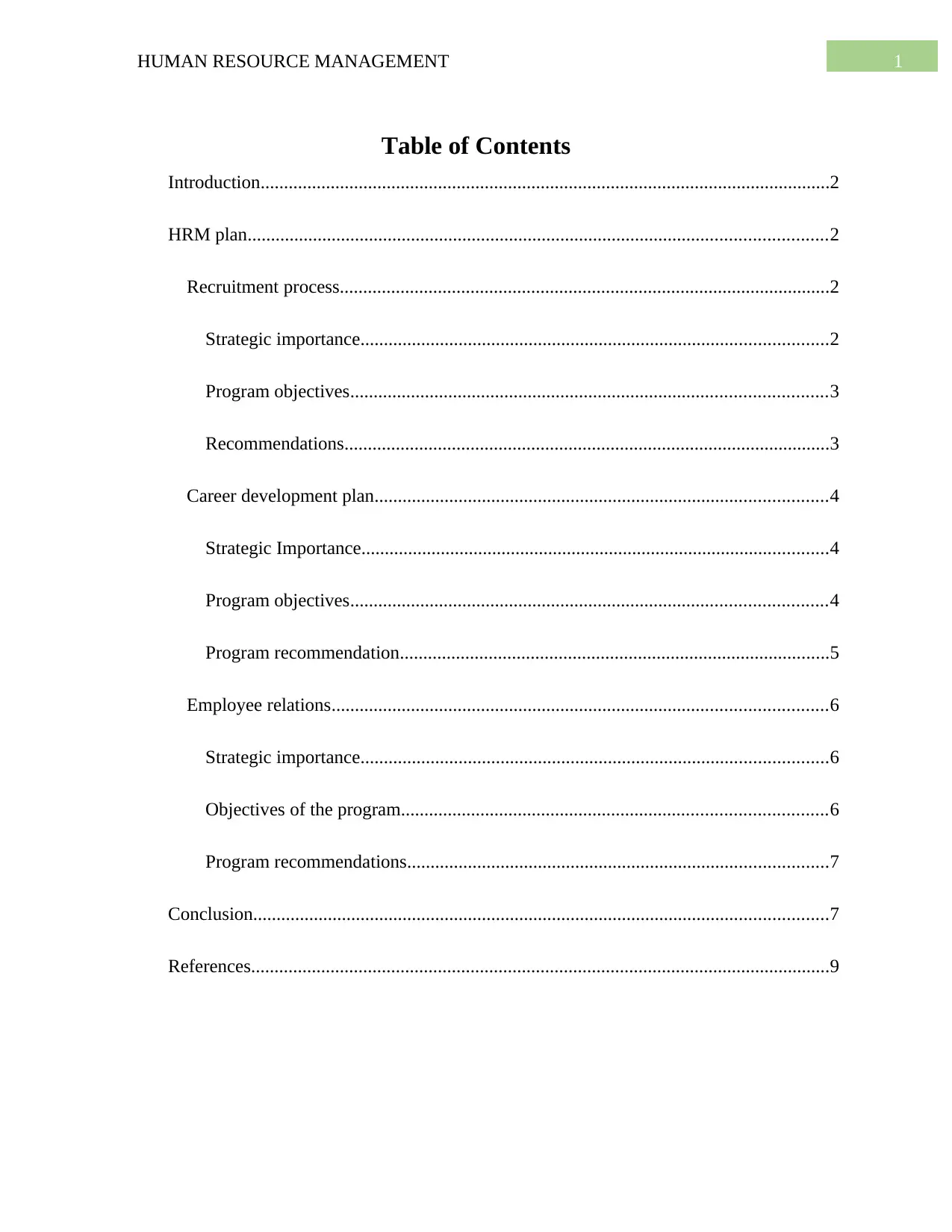
1HUMAN RESOURCE MANAGEMENT
Table of Contents
Introduction..........................................................................................................................2
HRM plan............................................................................................................................2
Recruitment process.........................................................................................................2
Strategic importance....................................................................................................2
Program objectives......................................................................................................3
Recommendations........................................................................................................3
Career development plan.................................................................................................4
Strategic Importance....................................................................................................4
Program objectives......................................................................................................4
Program recommendation............................................................................................5
Employee relations..........................................................................................................6
Strategic importance....................................................................................................6
Objectives of the program...........................................................................................6
Program recommendations..........................................................................................7
Conclusion...........................................................................................................................7
References............................................................................................................................9
Table of Contents
Introduction..........................................................................................................................2
HRM plan............................................................................................................................2
Recruitment process.........................................................................................................2
Strategic importance....................................................................................................2
Program objectives......................................................................................................3
Recommendations........................................................................................................3
Career development plan.................................................................................................4
Strategic Importance....................................................................................................4
Program objectives......................................................................................................4
Program recommendation............................................................................................5
Employee relations..........................................................................................................6
Strategic importance....................................................................................................6
Objectives of the program...........................................................................................6
Program recommendations..........................................................................................7
Conclusion...........................................................................................................................7
References............................................................................................................................9
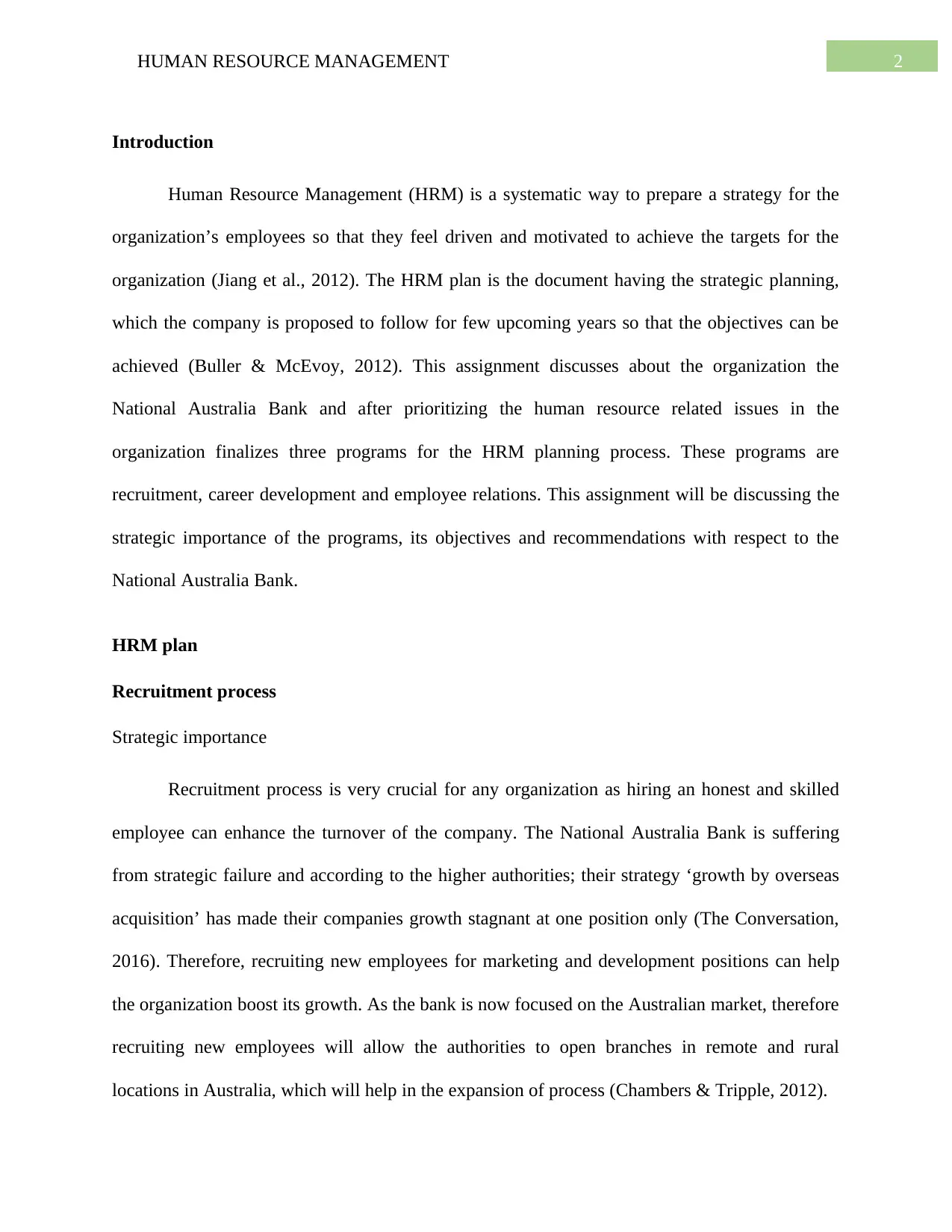
2HUMAN RESOURCE MANAGEMENT
Introduction
Human Resource Management (HRM) is a systematic way to prepare a strategy for the
organization’s employees so that they feel driven and motivated to achieve the targets for the
organization (Jiang et al., 2012). The HRM plan is the document having the strategic planning,
which the company is proposed to follow for few upcoming years so that the objectives can be
achieved (Buller & McEvoy, 2012). This assignment discusses about the organization the
National Australia Bank and after prioritizing the human resource related issues in the
organization finalizes three programs for the HRM planning process. These programs are
recruitment, career development and employee relations. This assignment will be discussing the
strategic importance of the programs, its objectives and recommendations with respect to the
National Australia Bank.
HRM plan
Recruitment process
Strategic importance
Recruitment process is very crucial for any organization as hiring an honest and skilled
employee can enhance the turnover of the company. The National Australia Bank is suffering
from strategic failure and according to the higher authorities; their strategy ‘growth by overseas
acquisition’ has made their companies growth stagnant at one position only (The Conversation,
2016). Therefore, recruiting new employees for marketing and development positions can help
the organization boost its growth. As the bank is now focused on the Australian market, therefore
recruiting new employees will allow the authorities to open branches in remote and rural
locations in Australia, which will help in the expansion of process (Chambers & Tripple, 2012).
Introduction
Human Resource Management (HRM) is a systematic way to prepare a strategy for the
organization’s employees so that they feel driven and motivated to achieve the targets for the
organization (Jiang et al., 2012). The HRM plan is the document having the strategic planning,
which the company is proposed to follow for few upcoming years so that the objectives can be
achieved (Buller & McEvoy, 2012). This assignment discusses about the organization the
National Australia Bank and after prioritizing the human resource related issues in the
organization finalizes three programs for the HRM planning process. These programs are
recruitment, career development and employee relations. This assignment will be discussing the
strategic importance of the programs, its objectives and recommendations with respect to the
National Australia Bank.
HRM plan
Recruitment process
Strategic importance
Recruitment process is very crucial for any organization as hiring an honest and skilled
employee can enhance the turnover of the company. The National Australia Bank is suffering
from strategic failure and according to the higher authorities; their strategy ‘growth by overseas
acquisition’ has made their companies growth stagnant at one position only (The Conversation,
2016). Therefore, recruiting new employees for marketing and development positions can help
the organization boost its growth. As the bank is now focused on the Australian market, therefore
recruiting new employees will allow the authorities to open branches in remote and rural
locations in Australia, which will help in the expansion of process (Chambers & Tripple, 2012).
⊘ This is a preview!⊘
Do you want full access?
Subscribe today to unlock all pages.

Trusted by 1+ million students worldwide
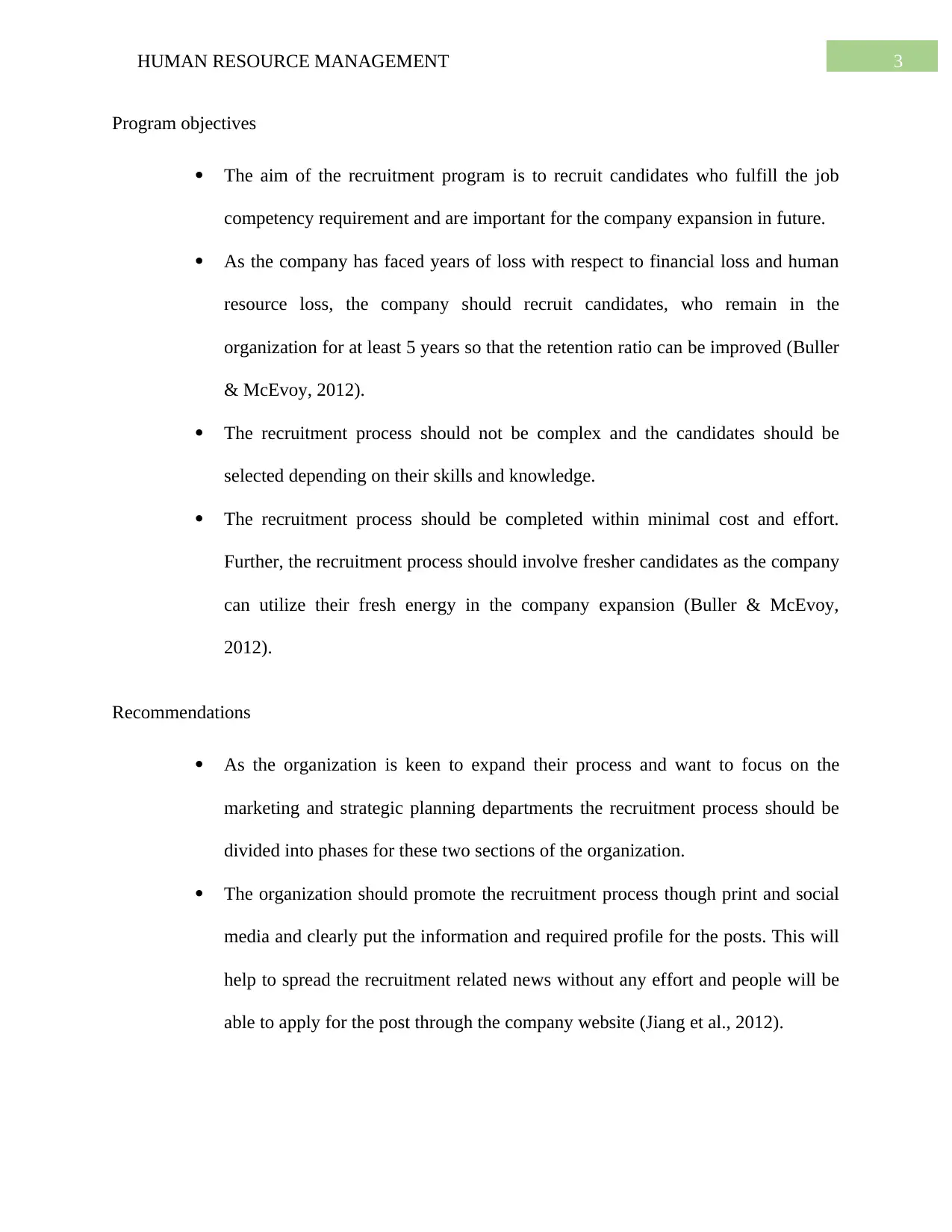
3HUMAN RESOURCE MANAGEMENT
Program objectives
The aim of the recruitment program is to recruit candidates who fulfill the job
competency requirement and are important for the company expansion in future.
As the company has faced years of loss with respect to financial loss and human
resource loss, the company should recruit candidates, who remain in the
organization for at least 5 years so that the retention ratio can be improved (Buller
& McEvoy, 2012).
The recruitment process should not be complex and the candidates should be
selected depending on their skills and knowledge.
The recruitment process should be completed within minimal cost and effort.
Further, the recruitment process should involve fresher candidates as the company
can utilize their fresh energy in the company expansion (Buller & McEvoy,
2012).
Recommendations
As the organization is keen to expand their process and want to focus on the
marketing and strategic planning departments the recruitment process should be
divided into phases for these two sections of the organization.
The organization should promote the recruitment process though print and social
media and clearly put the information and required profile for the posts. This will
help to spread the recruitment related news without any effort and people will be
able to apply for the post through the company website (Jiang et al., 2012).
Program objectives
The aim of the recruitment program is to recruit candidates who fulfill the job
competency requirement and are important for the company expansion in future.
As the company has faced years of loss with respect to financial loss and human
resource loss, the company should recruit candidates, who remain in the
organization for at least 5 years so that the retention ratio can be improved (Buller
& McEvoy, 2012).
The recruitment process should not be complex and the candidates should be
selected depending on their skills and knowledge.
The recruitment process should be completed within minimal cost and effort.
Further, the recruitment process should involve fresher candidates as the company
can utilize their fresh energy in the company expansion (Buller & McEvoy,
2012).
Recommendations
As the organization is keen to expand their process and want to focus on the
marketing and strategic planning departments the recruitment process should be
divided into phases for these two sections of the organization.
The organization should promote the recruitment process though print and social
media and clearly put the information and required profile for the posts. This will
help to spread the recruitment related news without any effort and people will be
able to apply for the post through the company website (Jiang et al., 2012).
Paraphrase This Document
Need a fresh take? Get an instant paraphrase of this document with our AI Paraphraser
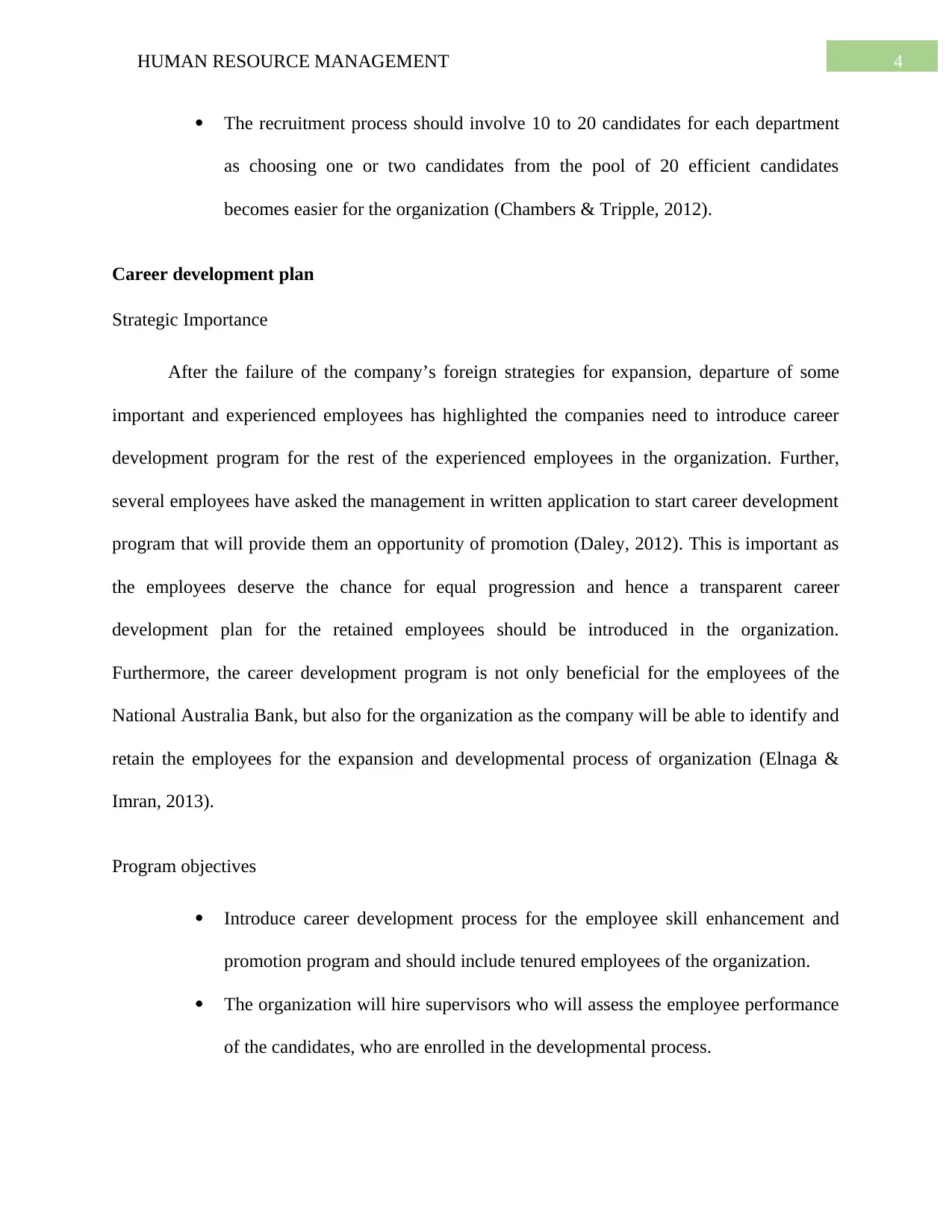
4HUMAN RESOURCE MANAGEMENT
The recruitment process should involve 10 to 20 candidates for each department
as choosing one or two candidates from the pool of 20 efficient candidates
becomes easier for the organization (Chambers & Tripple, 2012).
Career development plan
Strategic Importance
After the failure of the company’s foreign strategies for expansion, departure of some
important and experienced employees has highlighted the companies need to introduce career
development program for the rest of the experienced employees in the organization. Further,
several employees have asked the management in written application to start career development
program that will provide them an opportunity of promotion (Daley, 2012). This is important as
the employees deserve the chance for equal progression and hence a transparent career
development plan for the retained employees should be introduced in the organization.
Furthermore, the career development program is not only beneficial for the employees of the
National Australia Bank, but also for the organization as the company will be able to identify and
retain the employees for the expansion and developmental process of organization (Elnaga &
Imran, 2013).
Program objectives
Introduce career development process for the employee skill enhancement and
promotion program and should include tenured employees of the organization.
The organization will hire supervisors who will assess the employee performance
of the candidates, who are enrolled in the developmental process.
The recruitment process should involve 10 to 20 candidates for each department
as choosing one or two candidates from the pool of 20 efficient candidates
becomes easier for the organization (Chambers & Tripple, 2012).
Career development plan
Strategic Importance
After the failure of the company’s foreign strategies for expansion, departure of some
important and experienced employees has highlighted the companies need to introduce career
development program for the rest of the experienced employees in the organization. Further,
several employees have asked the management in written application to start career development
program that will provide them an opportunity of promotion (Daley, 2012). This is important as
the employees deserve the chance for equal progression and hence a transparent career
development plan for the retained employees should be introduced in the organization.
Furthermore, the career development program is not only beneficial for the employees of the
National Australia Bank, but also for the organization as the company will be able to identify and
retain the employees for the expansion and developmental process of organization (Elnaga &
Imran, 2013).
Program objectives
Introduce career development process for the employee skill enhancement and
promotion program and should include tenured employees of the organization.
The organization will hire supervisors who will assess the employee performance
of the candidates, who are enrolled in the developmental process.
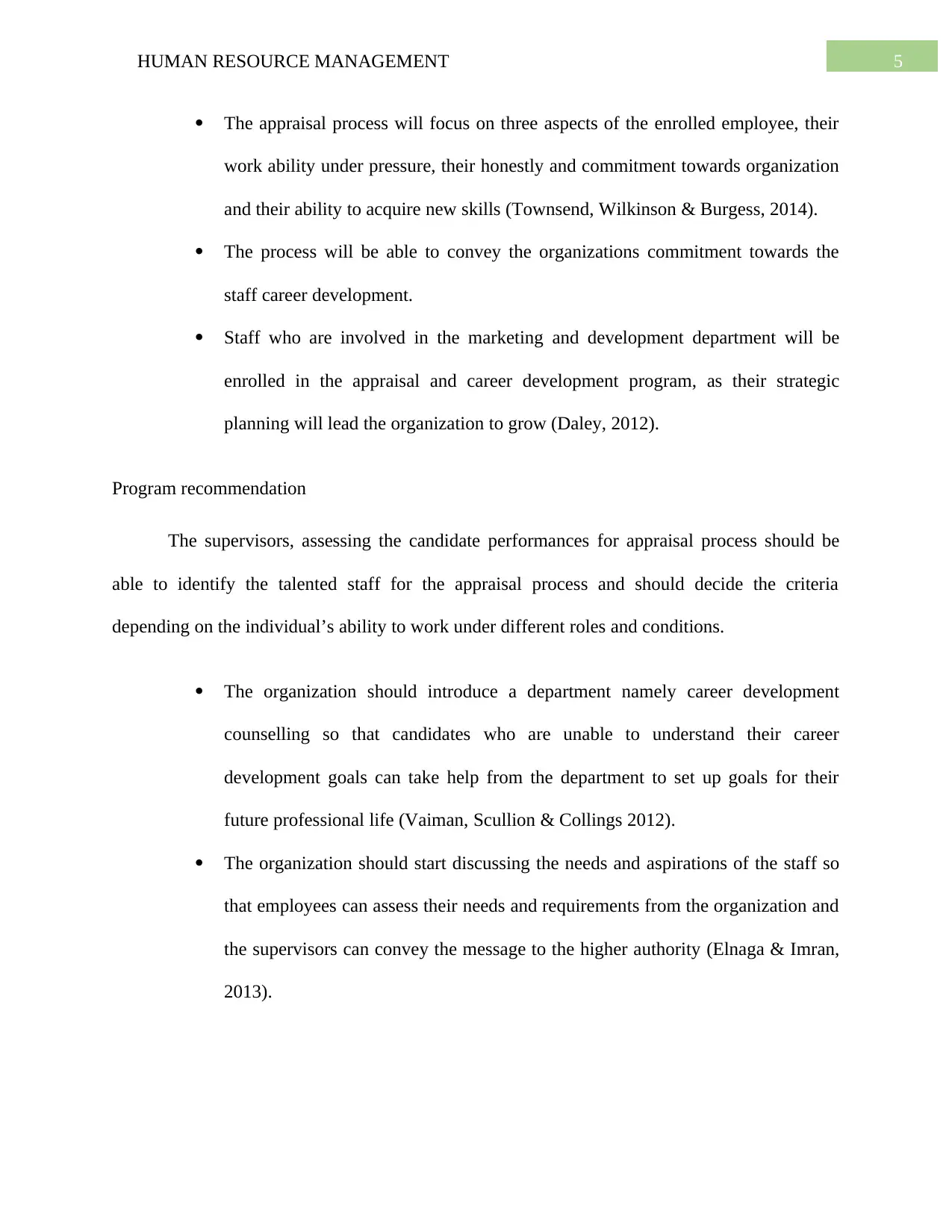
5HUMAN RESOURCE MANAGEMENT
The appraisal process will focus on three aspects of the enrolled employee, their
work ability under pressure, their honestly and commitment towards organization
and their ability to acquire new skills (Townsend, Wilkinson & Burgess, 2014).
The process will be able to convey the organizations commitment towards the
staff career development.
Staff who are involved in the marketing and development department will be
enrolled in the appraisal and career development program, as their strategic
planning will lead the organization to grow (Daley, 2012).
Program recommendation
The supervisors, assessing the candidate performances for appraisal process should be
able to identify the talented staff for the appraisal process and should decide the criteria
depending on the individual’s ability to work under different roles and conditions.
The organization should introduce a department namely career development
counselling so that candidates who are unable to understand their career
development goals can take help from the department to set up goals for their
future professional life (Vaiman, Scullion & Collings 2012).
The organization should start discussing the needs and aspirations of the staff so
that employees can assess their needs and requirements from the organization and
the supervisors can convey the message to the higher authority (Elnaga & Imran,
2013).
The appraisal process will focus on three aspects of the enrolled employee, their
work ability under pressure, their honestly and commitment towards organization
and their ability to acquire new skills (Townsend, Wilkinson & Burgess, 2014).
The process will be able to convey the organizations commitment towards the
staff career development.
Staff who are involved in the marketing and development department will be
enrolled in the appraisal and career development program, as their strategic
planning will lead the organization to grow (Daley, 2012).
Program recommendation
The supervisors, assessing the candidate performances for appraisal process should be
able to identify the talented staff for the appraisal process and should decide the criteria
depending on the individual’s ability to work under different roles and conditions.
The organization should introduce a department namely career development
counselling so that candidates who are unable to understand their career
development goals can take help from the department to set up goals for their
future professional life (Vaiman, Scullion & Collings 2012).
The organization should start discussing the needs and aspirations of the staff so
that employees can assess their needs and requirements from the organization and
the supervisors can convey the message to the higher authority (Elnaga & Imran,
2013).
⊘ This is a preview!⊘
Do you want full access?
Subscribe today to unlock all pages.

Trusted by 1+ million students worldwide
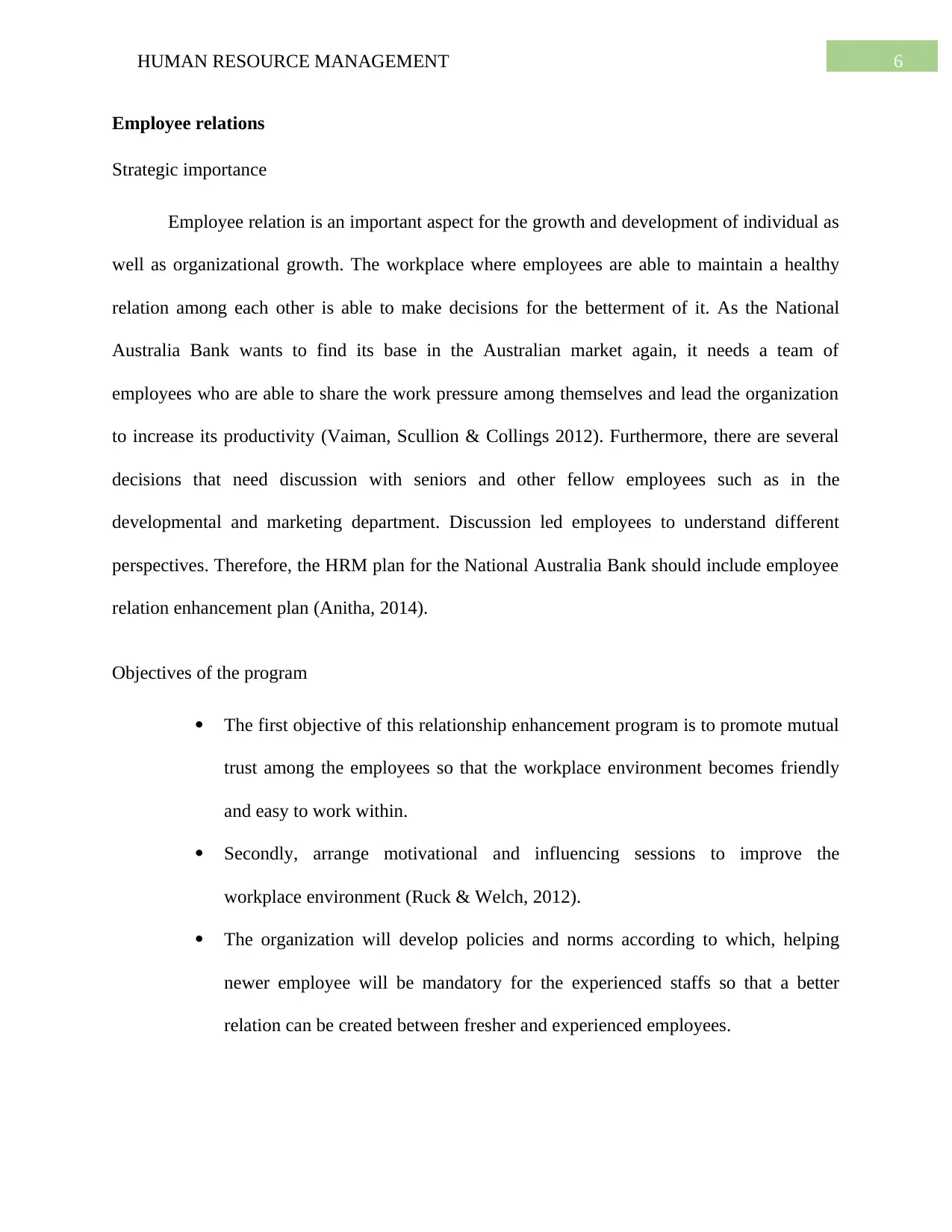
6HUMAN RESOURCE MANAGEMENT
Employee relations
Strategic importance
Employee relation is an important aspect for the growth and development of individual as
well as organizational growth. The workplace where employees are able to maintain a healthy
relation among each other is able to make decisions for the betterment of it. As the National
Australia Bank wants to find its base in the Australian market again, it needs a team of
employees who are able to share the work pressure among themselves and lead the organization
to increase its productivity (Vaiman, Scullion & Collings 2012). Furthermore, there are several
decisions that need discussion with seniors and other fellow employees such as in the
developmental and marketing department. Discussion led employees to understand different
perspectives. Therefore, the HRM plan for the National Australia Bank should include employee
relation enhancement plan (Anitha, 2014).
Objectives of the program
The first objective of this relationship enhancement program is to promote mutual
trust among the employees so that the workplace environment becomes friendly
and easy to work within.
Secondly, arrange motivational and influencing sessions to improve the
workplace environment (Ruck & Welch, 2012).
The organization will develop policies and norms according to which, helping
newer employee will be mandatory for the experienced staffs so that a better
relation can be created between fresher and experienced employees.
Employee relations
Strategic importance
Employee relation is an important aspect for the growth and development of individual as
well as organizational growth. The workplace where employees are able to maintain a healthy
relation among each other is able to make decisions for the betterment of it. As the National
Australia Bank wants to find its base in the Australian market again, it needs a team of
employees who are able to share the work pressure among themselves and lead the organization
to increase its productivity (Vaiman, Scullion & Collings 2012). Furthermore, there are several
decisions that need discussion with seniors and other fellow employees such as in the
developmental and marketing department. Discussion led employees to understand different
perspectives. Therefore, the HRM plan for the National Australia Bank should include employee
relation enhancement plan (Anitha, 2014).
Objectives of the program
The first objective of this relationship enhancement program is to promote mutual
trust among the employees so that the workplace environment becomes friendly
and easy to work within.
Secondly, arrange motivational and influencing sessions to improve the
workplace environment (Ruck & Welch, 2012).
The organization will develop policies and norms according to which, helping
newer employee will be mandatory for the experienced staffs so that a better
relation can be created between fresher and experienced employees.
Paraphrase This Document
Need a fresh take? Get an instant paraphrase of this document with our AI Paraphraser
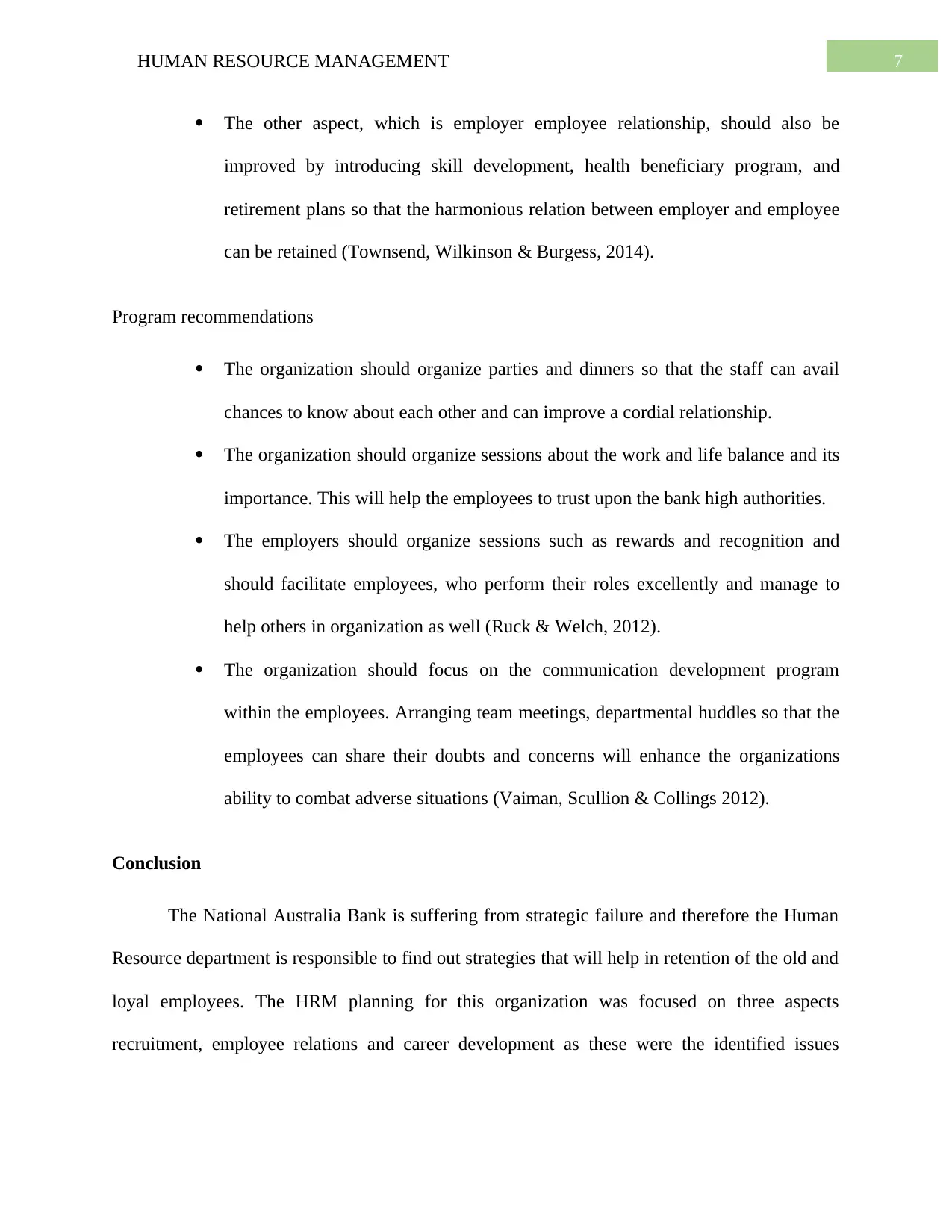
7HUMAN RESOURCE MANAGEMENT
The other aspect, which is employer employee relationship, should also be
improved by introducing skill development, health beneficiary program, and
retirement plans so that the harmonious relation between employer and employee
can be retained (Townsend, Wilkinson & Burgess, 2014).
Program recommendations
The organization should organize parties and dinners so that the staff can avail
chances to know about each other and can improve a cordial relationship.
The organization should organize sessions about the work and life balance and its
importance. This will help the employees to trust upon the bank high authorities.
The employers should organize sessions such as rewards and recognition and
should facilitate employees, who perform their roles excellently and manage to
help others in organization as well (Ruck & Welch, 2012).
The organization should focus on the communication development program
within the employees. Arranging team meetings, departmental huddles so that the
employees can share their doubts and concerns will enhance the organizations
ability to combat adverse situations (Vaiman, Scullion & Collings 2012).
Conclusion
The National Australia Bank is suffering from strategic failure and therefore the Human
Resource department is responsible to find out strategies that will help in retention of the old and
loyal employees. The HRM planning for this organization was focused on three aspects
recruitment, employee relations and career development as these were the identified issues
The other aspect, which is employer employee relationship, should also be
improved by introducing skill development, health beneficiary program, and
retirement plans so that the harmonious relation between employer and employee
can be retained (Townsend, Wilkinson & Burgess, 2014).
Program recommendations
The organization should organize parties and dinners so that the staff can avail
chances to know about each other and can improve a cordial relationship.
The organization should organize sessions about the work and life balance and its
importance. This will help the employees to trust upon the bank high authorities.
The employers should organize sessions such as rewards and recognition and
should facilitate employees, who perform their roles excellently and manage to
help others in organization as well (Ruck & Welch, 2012).
The organization should focus on the communication development program
within the employees. Arranging team meetings, departmental huddles so that the
employees can share their doubts and concerns will enhance the organizations
ability to combat adverse situations (Vaiman, Scullion & Collings 2012).
Conclusion
The National Australia Bank is suffering from strategic failure and therefore the Human
Resource department is responsible to find out strategies that will help in retention of the old and
loyal employees. The HRM planning for this organization was focused on three aspects
recruitment, employee relations and career development as these were the identified issues
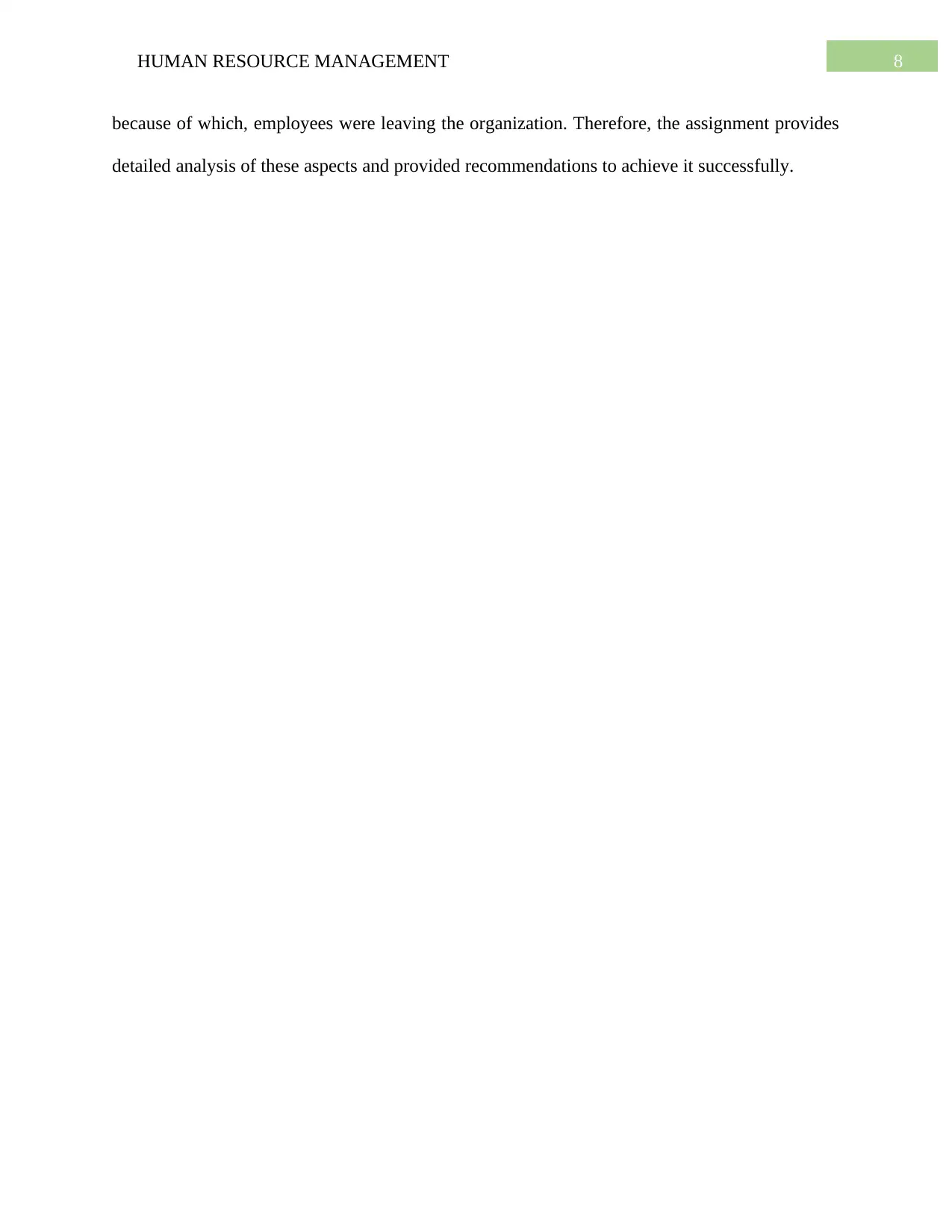
8HUMAN RESOURCE MANAGEMENT
because of which, employees were leaving the organization. Therefore, the assignment provides
detailed analysis of these aspects and provided recommendations to achieve it successfully.
because of which, employees were leaving the organization. Therefore, the assignment provides
detailed analysis of these aspects and provided recommendations to achieve it successfully.
⊘ This is a preview!⊘
Do you want full access?
Subscribe today to unlock all pages.

Trusted by 1+ million students worldwide
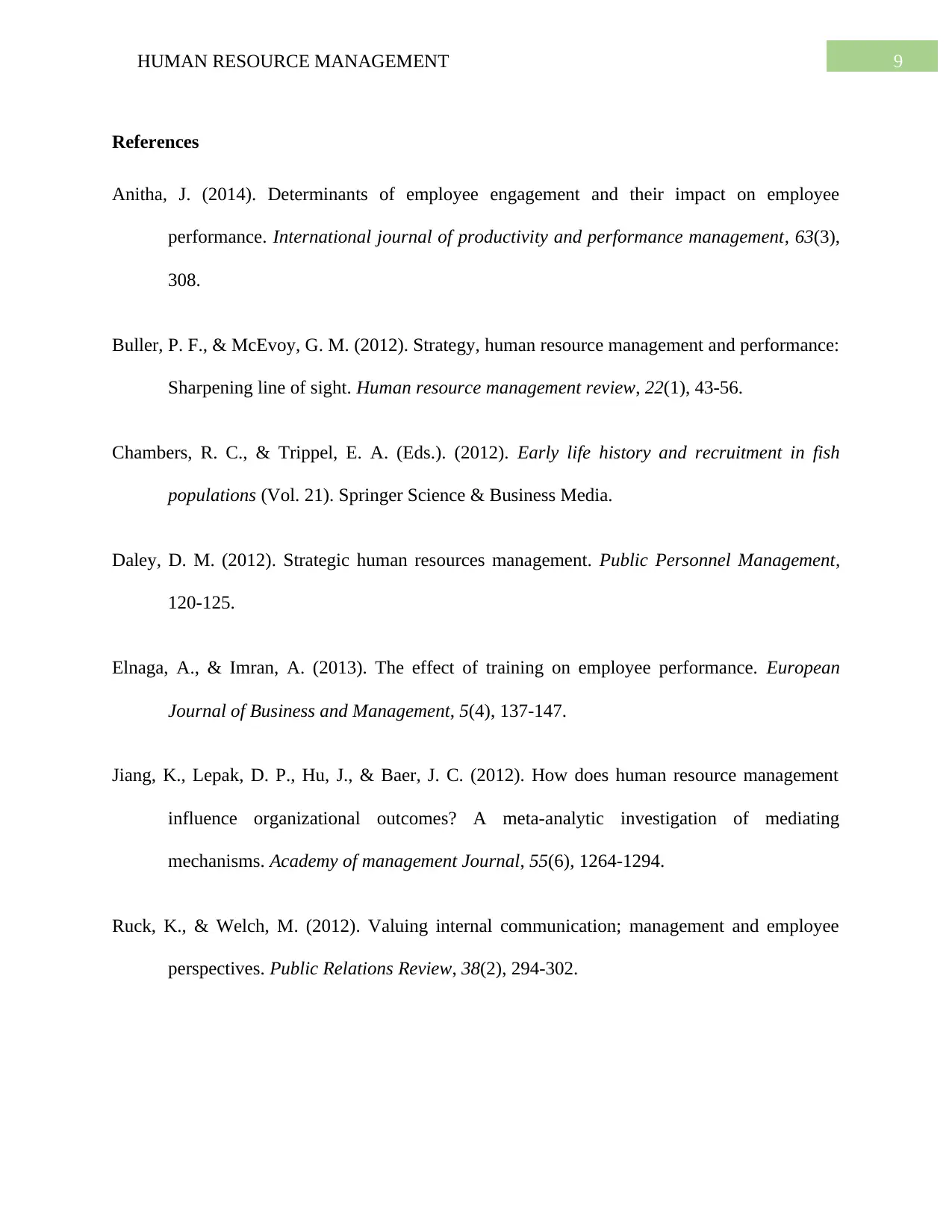
9HUMAN RESOURCE MANAGEMENT
References
Anitha, J. (2014). Determinants of employee engagement and their impact on employee
performance. International journal of productivity and performance management, 63(3),
308.
Buller, P. F., & McEvoy, G. M. (2012). Strategy, human resource management and performance:
Sharpening line of sight. Human resource management review, 22(1), 43-56.
Chambers, R. C., & Trippel, E. A. (Eds.). (2012). Early life history and recruitment in fish
populations (Vol. 21). Springer Science & Business Media.
Daley, D. M. (2012). Strategic human resources management. Public Personnel Management,
120-125.
Elnaga, A., & Imran, A. (2013). The effect of training on employee performance. European
Journal of Business and Management, 5(4), 137-147.
Jiang, K., Lepak, D. P., Hu, J., & Baer, J. C. (2012). How does human resource management
influence organizational outcomes? A meta-analytic investigation of mediating
mechanisms. Academy of management Journal, 55(6), 1264-1294.
Ruck, K., & Welch, M. (2012). Valuing internal communication; management and employee
perspectives. Public Relations Review, 38(2), 294-302.
References
Anitha, J. (2014). Determinants of employee engagement and their impact on employee
performance. International journal of productivity and performance management, 63(3),
308.
Buller, P. F., & McEvoy, G. M. (2012). Strategy, human resource management and performance:
Sharpening line of sight. Human resource management review, 22(1), 43-56.
Chambers, R. C., & Trippel, E. A. (Eds.). (2012). Early life history and recruitment in fish
populations (Vol. 21). Springer Science & Business Media.
Daley, D. M. (2012). Strategic human resources management. Public Personnel Management,
120-125.
Elnaga, A., & Imran, A. (2013). The effect of training on employee performance. European
Journal of Business and Management, 5(4), 137-147.
Jiang, K., Lepak, D. P., Hu, J., & Baer, J. C. (2012). How does human resource management
influence organizational outcomes? A meta-analytic investigation of mediating
mechanisms. Academy of management Journal, 55(6), 1264-1294.
Ruck, K., & Welch, M. (2012). Valuing internal communication; management and employee
perspectives. Public Relations Review, 38(2), 294-302.
Paraphrase This Document
Need a fresh take? Get an instant paraphrase of this document with our AI Paraphraser
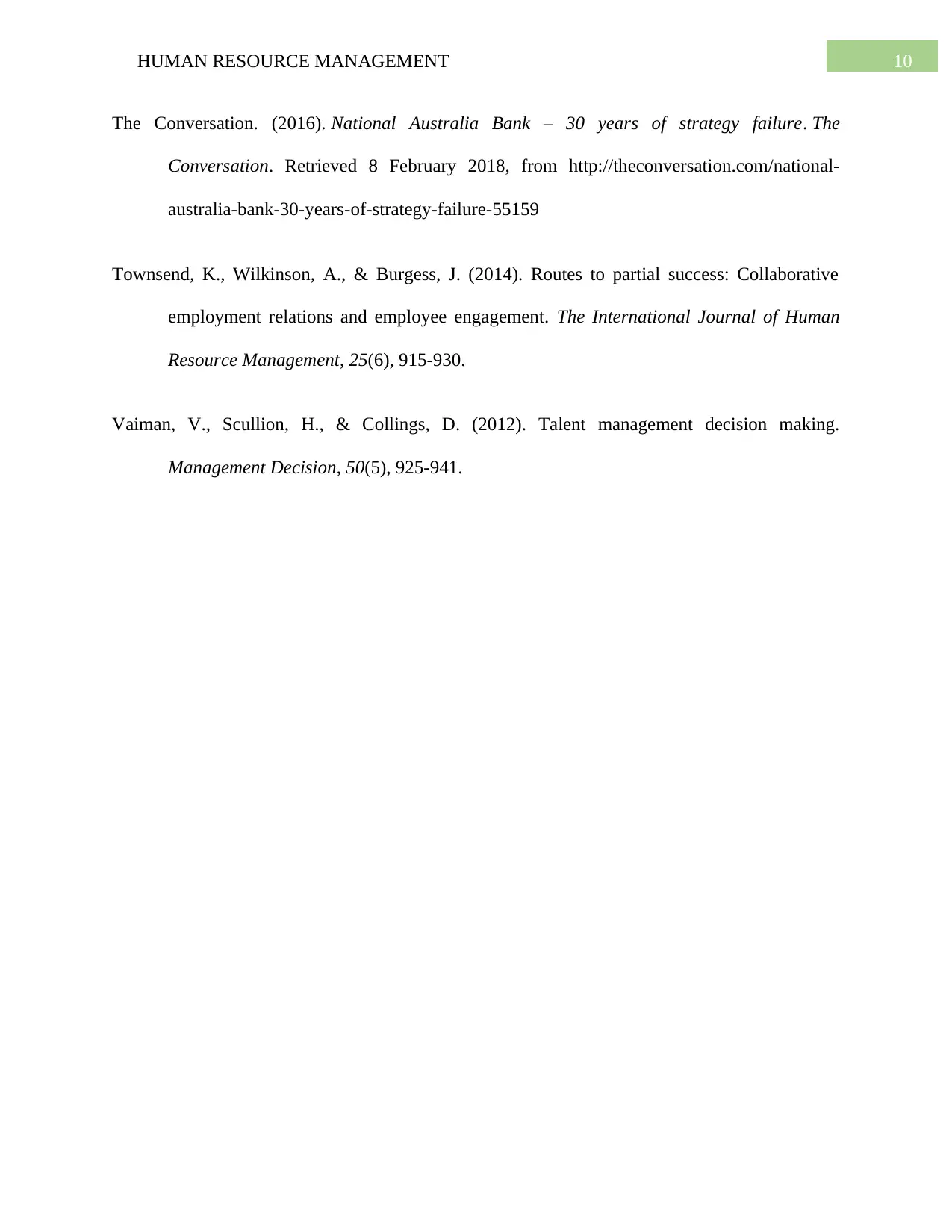
10HUMAN RESOURCE MANAGEMENT
The Conversation. (2016). National Australia Bank – 30 years of strategy failure. The
Conversation. Retrieved 8 February 2018, from http://theconversation.com/national-
australia-bank-30-years-of-strategy-failure-55159
Townsend, K., Wilkinson, A., & Burgess, J. (2014). Routes to partial success: Collaborative
employment relations and employee engagement. The International Journal of Human
Resource Management, 25(6), 915-930.
Vaiman, V., Scullion, H., & Collings, D. (2012). Talent management decision making.
Management Decision, 50(5), 925-941.
The Conversation. (2016). National Australia Bank – 30 years of strategy failure. The
Conversation. Retrieved 8 February 2018, from http://theconversation.com/national-
australia-bank-30-years-of-strategy-failure-55159
Townsend, K., Wilkinson, A., & Burgess, J. (2014). Routes to partial success: Collaborative
employment relations and employee engagement. The International Journal of Human
Resource Management, 25(6), 915-930.
Vaiman, V., Scullion, H., & Collings, D. (2012). Talent management decision making.
Management Decision, 50(5), 925-941.
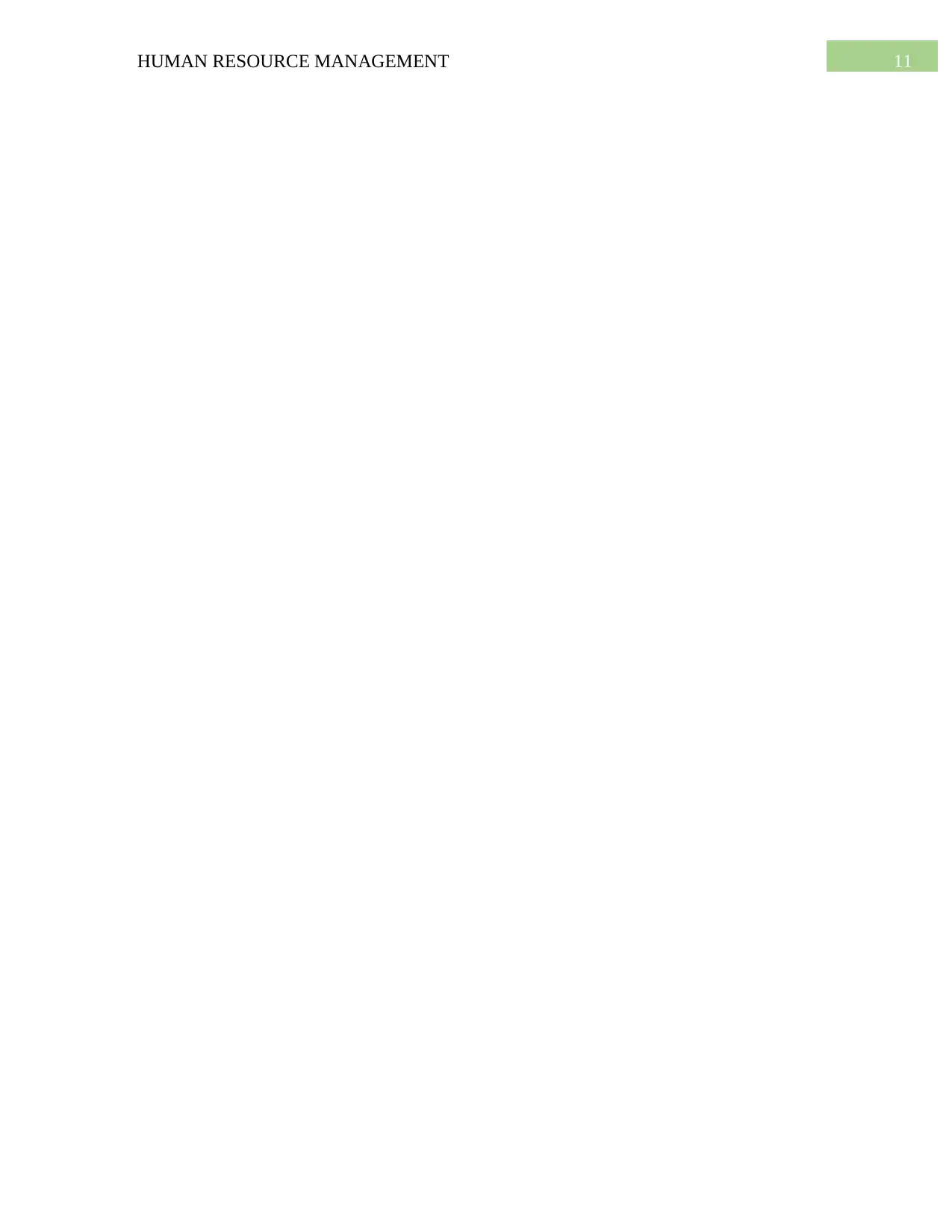
11HUMAN RESOURCE MANAGEMENT
⊘ This is a preview!⊘
Do you want full access?
Subscribe today to unlock all pages.

Trusted by 1+ million students worldwide
1 out of 12
Related Documents
Your All-in-One AI-Powered Toolkit for Academic Success.
+13062052269
info@desklib.com
Available 24*7 on WhatsApp / Email
![[object Object]](/_next/static/media/star-bottom.7253800d.svg)
Unlock your academic potential
Copyright © 2020–2025 A2Z Services. All Rights Reserved. Developed and managed by ZUCOL.





